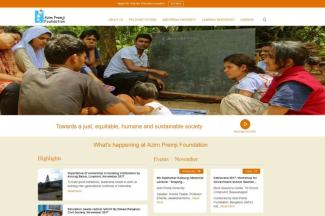Promoting change
From individual charity to impact-investing

India is a nation of huge social disparities. Several hundred million people live in desperate poverty amidst incredible individual wealth (see my essay in D+C/E+Z e-Paper 2017/05, p. 29). India has the world’s seventh largest number of billionaires of 90, with total wealth of $ 206 billion, according to international business consultancy Bain (2017).
All major religious faiths in the country emphasise the duty to aid those who are worse off than oneself; prosperous industrialists have willingly complied with such traditions (see box). However, they are increasingly taking business-like, professional approaches in what is called corporate social responsibility (CSR) to focus on critical voids.
Bain’s recently published “India Philanthropy Report 2017” states that the nation must plug public-budget gaps worth $ 8.5 trillion if it is to achieve the UN Sustainable Development Goals (SDGs) by 2030. It states: “It needs significant additional funds, along with systemic changes at the policy and service-delivery levels, to achieve these goals. Although the government remains the largest enabler of change, the role of private philanthropy is critical.”
Traditionally, wealthy business families have long since acted charitably. This is true of dynastic names including Tata, Birla, Bajaj, Godrej, Mahindra and many others. Leading India’s independence movement, Mahatma Gandhi exhorted businesses to invest in social development for the greater good. Accordingly, funds were invested in education, health, rural development, water projects and movements to abolish untouchability.
Post-independence entrepreneurs have joined in. Azim Premji, the chairman of the IT service company Wipro, invested $ 2 billion worth of shares in his philanthropic Azim Premji Foundation, for example. The Shanghai-based data company Hurun, which regularly compiles an India Philanthropy List, says that Shiv Nadar (HCL Technologies), Kris Gopalakrishnan (Infosys) and his wife Sudha and Mukesh Ambani (Reliance Industries) were the most generous individual Indian donors last year. Nadar, the top donor, spent the equivalent of € 82 million on worthy causes, mostly promoting education. The Gopalakrishnans (€ 41 million) and Ambani (€ 39 million) supported education, health care, rural and social development amongst other things.
The current crop of Indian philanthropists are influenced by international role models, especially North American ones, though there is a clash of traditions. Earlier, Indian business leaders kept silent about their charities. Infosys chairman Narayan Murthy says: “I personally believe that philanthropy should not be talked about much.” Ajay Piramal, from a long-established business family engaging in philanthropy, shared that view earlier. Today, he says that the examples set by Warren Buffett and Bill Gates have inspired him to adopt a different attitude: “So, now I’ve started talking about the work we do.”
Change is evident in other ways too. Dasra, an Indian philanthropy foundation which focuses on strategic issues, urges philanthropists to go beyond immediate, individual impact and think of collective action. Dasra means “enlightened giving” in Sanskrit, and its sponsors include Indian as well as multinational corporations. Its mission is to compile data, provide advice and draft strategies.
The Tata Trust shares Dasra’s view: “India has to move like other countries into a more sophisticated form of philanthropy, which makes a difference and is designed to make a difference rather than just creating edifices.” The Trust has an excellent reputation and a long history. It started as the JN Tata Endowment Scheme 125 years ago (see my essay in D+C/E+Z 2015/12, p. 19, print edition 2016/01-02, p. 32).
Today, India’s philanthropic foundations and trusts are trying to deliver pan-Indian solutions and create platforms for cooperation with a broad variety of partners, including government agencies, private-sector businesses, civil-society organisations, multilateral agencies, think tanks et cetera. Due to the professionalisation of charities, the philanthropic institutions are increasingly becoming independent from family businesses.
The Tata Trust, for instance, has signed up with the Department of Science and Technology to fund social enterprises. It is collaborating with the state government of Maharashtra to facilitate a social transformation project that would impact 1,000 villages. In cooperation with the Khan Academy, an online education provider, it is rolling out e-learning programmes in government schools across a dozen Indian states.
The Mahindra-owned Naandi Foundation has a team of more than 300 full-time professionals and more than 3,000 front-line development workers, often recruited and trained from within the communities. It has its footprints in 16 Indian states, including some of the biggest. Naandi is touching the lives of more than 5 million underserved people. Its agenda includes the promotion of safe drinking water, urban elementary schools, training for unemployed youth, agriculture marketing support to tribals and other things.
It has even opened an exclusive retail store in Paris, marking the global debut of a luxury Indian coffee brand, “Araku”, a home-grown blend of Arabica coffee cultivated by the tribes of Araku Valley in Andhra Pradesh, using advanced bio-dynamic farming practices.
Points of criticism
While India does need large-scale philanthropy to drive social innovation and compensate for the stodgy bureaucratic ways, the rise of philanthropy does have downsides. Some 120 million small and localised programmes are suddenly bereft of support. The withdrawal of funding in favour of big-ticket philanthropy has taken its toll.
Making matters worse, the central government has been cracking down on non-governmental organisations, especially those that get funding from overseas. The government argues that they are fomenting anti-nationalism, though many of them are providing essential services and giving voice to legitimate grievances. That the central government only wants philanthropy with a servile mindset, does not augur well for the nation’s future.
Not all corporate action is entirely voluntary moreover. The government requires private-sector businesses with annual revenues of more than the equivalent of € 120 million to earmark two percent of their net profit for CSR. Corporate measures to comply with this demand tend to be designed in ways that serve the interests of the sponsoring company as well.
It is even worse that philanthropic institutions sometimes help owners to dodge taxes. In a country, where corruption is common, this is no surprise. Charitable action can be tainted in other ways too. In 2015, a major scam involving educational trusts was uncovered. Money worth tens of millions of euros had been siphoned off.
Aditi Roy Ghatak is a freelance journalist based in Kolkata.
aroyghatak1956@gmail.com
Links
Bain and Company, 2017: India Philanthropy Report 2017.
http://www.bain.com/publications/articles/india-philanthropy-report-2017.aspx
Naandi Foundation:
https://www.facebook.com/NaandiFoundation/













